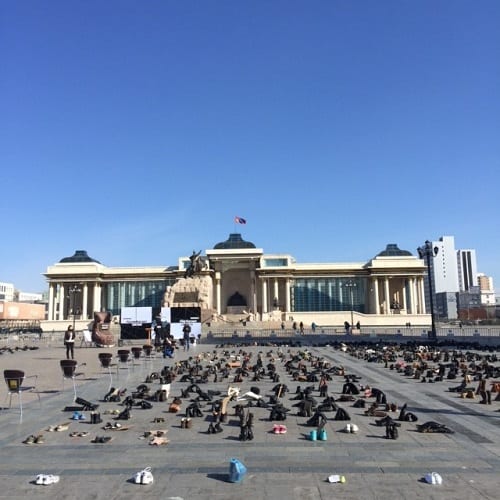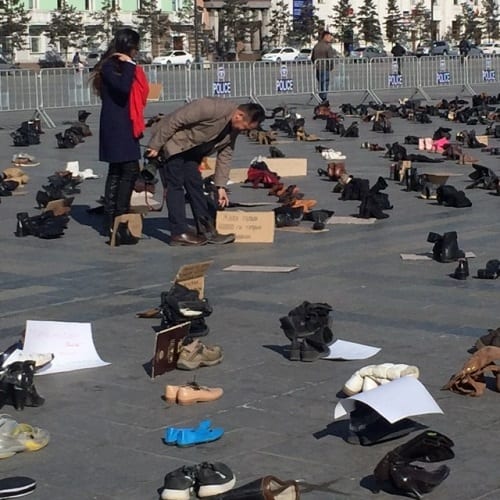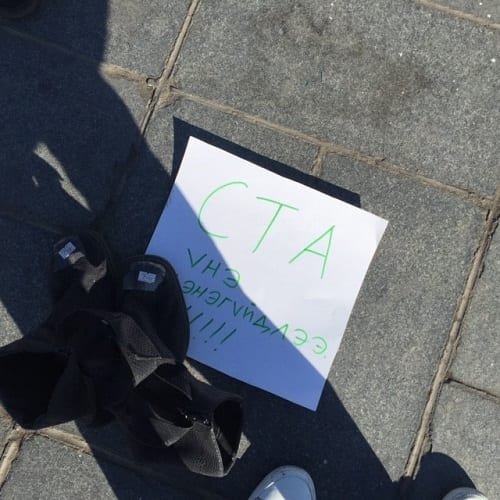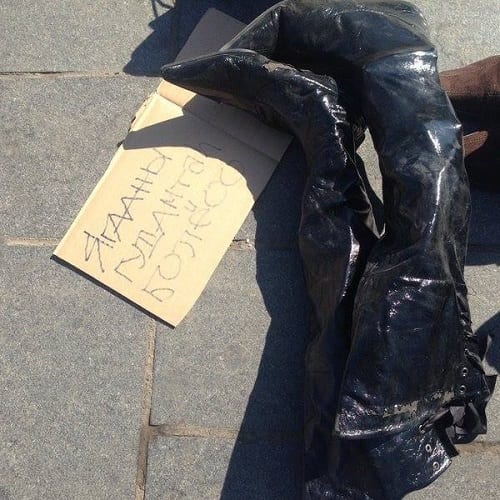New Forms of Political Protests in Ulaanbaatar: Calling for Justice through Shoes
By uczipm0, on 28 April 2016
This post was written by Sh. Tuya, a researcher on the Emerging Subjects project.
On April 7th, the Chinggis Khaan Square in front of the government palace was covered in shoes of all variety. Strikingly, the protest was a quiet space devoid of people themselves protesting. The protest was part of series of campaigns organized by the Mongolian Youth Association (further referred as MYA), titled Mongolia without Thieves: Black List, White List.
Black List, White List
The black list was compiled by the MYA and includes names of public figures that should not be permitted to run in rural constituencies for parliamentary elections and the Citizen’s Representative Khural.[1] The release of the list as mentioned by the President of the MYA was scheduled to take place on October 2nd, 2015, the day that S, Zorig, the leader of democratic movements in Mongolia, was assassinated.[2] However, the release of the list was postponed until closer to the elections in spring. The campaign was criticized by another youth association, mainly the Union of Mongolian Students (further referred as UMS) for politicizing the MYA and implicating it in political party propaganda.[3] The statement was released after the end of a brief coalition between the MYA and UMS in spring. According to the press release, the UMS was abandoning the coalition because of the list and because the MYA’s new board members have a political background. The statement further emphasized that non-government organization such as the MYA do not have legitimate right to accuse individuals without proper legal procedure and that only the justice system has a right to issue trials and pardoning procedures.[4]
Why Shoes and Not Faces?
The shoe protests in Ulaanbaatar first struck me as similar to the shoe protest in Paris last fall, where 10,000 shoes that stood in for a large protest that was cancelled during the Paris Climate Talks following attacks on the city. However this protest, unlike its original counterpart in Paris, was not seeking to address a global environmental issue and there wasn’t a ban on authorized demonstrations in Ulaanbaatar.
The shoe protest took place for one day in a controlled space on the far west side of the square. All the shoes were placed in space fenced off by the police. At the center of the fenced-in space stood a giant shoe with a display covered in black and white reading: “White List: We Will Elect, Let’s Liberate!” When I entered the fence to snap photographs of the shoes, I noticed small tablets attached to each pair with individual pleas. The tablets read a range of frustrations covering many aspects of society, including political, economic, culture and even the sex industry.
For instance, one pair of shoes complained about the devaluation of meritorious titles that have existed since the socialist era, such as STA “Soyolyn Terguunii Ajiltan” (Leading Cultural Worker). A pair of worn out boots proposed to legalize sex workers and allocate a street for them. The messages on tablets were very broad and subjective, which did not sit well with just the political agenda of the upcoming elections.
The overall site was modest in size, with a few curious people approaching the table where pamphlets were given out. I arrived there at 11 in the morning during a workday and most of the small crowd of people consisted of elderly people, students who worked at the booth, and several journalists snapping photos. If a young population of workers and students wanted to show their frustration, this was indeed a convenient method of protest with no missed office hours or classes. Even though the title, White List/Black List, seemed threatening, the protest itself did not feel this way.
Hashtag #хөлфи (#shoelfie): Active social media discussions versus absent physical protest
The media coverage of the protest was quite high both in official outlets, as well as on social networking websites, especially Twitter. A Twitter hashtag, #хөлфи –meaning shoelfie, a reference to shoe selfies – went viral.
Both the form of the protest and its performative aspect point to specific aesthetics that are emerging as civil society critique of the failures of the state. The appeal of the faceless protest was novel in its performative approach, which resonated well with the internet culture where people are expected to perform a certain role on a daily basis. The political message of the protest outlined the appeal of the moral aesthetics of politics. The range of individual messages all united under the face of black and white questioned what is good and beautiful as opposed to bad and repulsive. Perhaps, that’s why the messages even included frustrations with so many clandestine topics that are not discussed in public life, such as legalization of sex workers, getting rid of useless artist titles, and lack of cash money among students.
Furthermore, given that the public is becoming increasingly aware of censorship and surveillance, a ‘faceless’ protest of shoes may seem to be a less risky protest strategy. Since there were no faces or names associated with the shoes, the identities of the shoes’ owners is unknown. This is not the first time such a ‘faceless’ protest has been carried out in Mongolia. In 2014, people protesting uranium mining and the disposal of radioactive waste in Mongolia donned masks similar to those used by the Anonymous movement during a protest in Chinggis Square.
Vita Peacock, an anthropologist at UCL who studies forms of street protest such as the Anonymous movement, observers that, “the point of being present then, is not to do one thing but to question another.” [5] The performative aspect of anonymity points to the theatrical concept of the double: the functioning of body, an emptied vessel without identifiable subject, and what it represents. Such anonymity allows for direct non-violent action against established hierarchy, according to anarchist anthropologist, David Graber.[6] The performance guarantees the anonymity of identities that otherwise would threaten directly the fragile state of consensus between the state and the society. Whereas, the physical presence of empty forms of materiality – such as shoes – still challenges the stable understanding of society.
Thank you to my research partner, Lauren Bonilla, for contributing to this post.
All photos © of Sh. Tuya.
[1] The Citizens Representatives Khural is an elected, quasi-state institution that is meant to support local, regional, and urban governance ( http://www.khural.mn/en-us/n/8xyy).
[2] http://khulgaichguimongol.myf.mn/
[3] http://www.bolod.mn/News/146486.html
[4] http://www.bolod.mn/News/146486.html
[5] See Vita Peacock on Anonymous Movements in London: http://allegralaboratory.net/million-mask-marching-performance/
[6] David Graeber, 2004, “Fragments of an Anarchist Antrhopology”, p, 94. Prickly Paradigm Press.
 Close
Close







